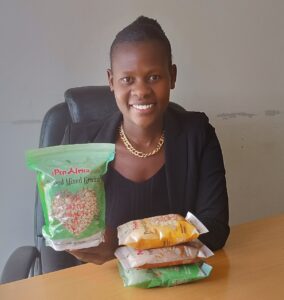20 November 2023. Millet: How to Create a Business Around Neglected and Underutilized Species?
How innovative approaches and creative thinking can reintroduce sustainable, nutrient-dense ingredients like millet and sorghum into children's diets. Discover the potential of neglected and underutilized species and learn how to turn innovative ideas into successful businesses.Speakers:
- Ms Shauravi Malik: Co-founder of Slurpp Farm, an Indian startup
Slurrp Farm was born from the concern of two mothers who realised that the current food system is broken, and requires innovation and creativity to re-introduce sustainable, nutrient dense and diverse ingredients back into our children’s diet. This we thought is the best way to ensure that kids, farmers and the planet stay happy.
Shauravi's passion is to get her own children to gobble up all the exciting and healthy food she makes. She loves food, eating it and making it! Shauravi brings over a decade of finance experience. She worked in the Consumer, Healthcare, and Retail Advisory team and the Leveraged Finance team at J.P.Morgan. She was an Investment Manager at Sir Richard Branson's Group Holding entity at the Virgin Group in London. She holds a Master's degree in Economics from Cambridge University and a BA in Economics from St. Stephen's College, Delhi University. - Ms Joanna Kane Potaka: Deputy Executive Director for Strategy, Engagement, and Impact at the International Rice Research Institute (IRRI).
Recording
Related:
Recognizing the value of millet and millet-based products in Kenya
Dorah Momanyi, is the founder of the Nutritious Agriculture Network in Kenya. In her work, she re-establishes the use of indigenous grains, such as sorghum, amaranth and millet, by making plant-based snacks.Millets are still considered food for people experiencing poverty. Millennials and Generation Z actually cannot even identify the type of millet in Kenya. They shy away and scorn millet as food for our ancestors. In the Kisii and Luo community, millet is a significant crop used in traditional ceremonies that lead up to weddings.
Despite the availability of many cereal options, people still tend to choose alternative cereals. In Kenya, for example, maize is the staple food, and it is challenging to change the consumption patterns of a population.Moreover, millet planting, harvesting, threshing, and storage are all done manually, which makes it a tedious process. Due to the lack of adequate markets and low returns, many large-scale farmers avoid cultivating it. The consumption of common millet-based products, such as porridge and ugali, is low as they are not attractive to eat. Additionally, they are typically only consumed as a main meal and porridge is only eaten occasionally.
Some research institutes, including the Kenya Agricultural and Livestock Research Organization (KALRO), are focusing on traditional indigenous grains and African leafy vegetables. The momentum geared towards funding startups in the indigenous food space is just beginning to take its footing.
During the International Year of Millet, the Ministry of Agriculture developed and showcased millet-based food products. The National Flour Blending Policy requires millers to add alternative grains to maize flour, increasing the use of millet.




No comments:
Post a Comment